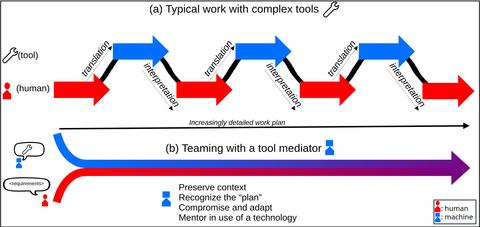Summary
Small and medium-sized manufacturers (SMMs) are falling behind larger firms in efficiency and productivity, and this gap is widening [1, 2]. This is particularly concerning because SMMs, manufacturers employing 500 or fewer workers, account for 43 percent of all US manufacturing employment and about half of the nation’s manufacturing services and products [3]. It is not clear whether the advance of AI will help SMMs reduce the productivity gap to larger enterprises. Becoming more efficient, productive, and resilient is largely a matter of learning how to use new tools and techniques. However, small manufacturers are challenged to connect with supporting institutions and find guidance in technical areas [1].
It is widely believed that AI is changing the nature of work. The aim of the Human/Machine Teaming for Manufacturing Digital Twins project is to establish techniques and measurement science by which some of the complex tools of manufacturing, including digital twins and decision support systems, can be used effectively through productive, incremental exposure to their capabilities. Generative AI and domain-specific languages for manufacturing tasks may make it possible to accelerate learning and narrow the gap between large and small manufacturers in the use of complex tools.
Description

Teaming with AI reduces the cost of using complex tools
Objective
To remove barriers to the use of complex tools in manufacturing, such as digital twins, by developing the foundation for integrating generative AI, declarative domain-specific languages, and human/AI teaming.
Technical Idea
The mission of NIST’s Engineering Laboratory includes researching methods to make US manufacturing more resilient. In manufacturing, resilience is largely the ability to learn new capabilities. In its first year, the project focused on how people can best team with AI to learn a popular language for constraint-based optimization, MiniZinc, and use it to develop a bespoke scheduling system for their production. We pair generative AI with AI planning in a chat-based environment to interview people about their production scheduling problem and, in the process, formulate a solution in the MiniZinc domain-specific language. This research serves as a springboard for out-of-year development of best practices and measurement science for similar tasks, such as teaming to integrate digital twins into production operations.
Research Areas
The Teaming project seeks to develop measurement science and solutions in the following areas:
- AI-mediated manufacturing systems integration.
- Designing domain-specific languages (DSLs) fit for human/machine teaming
- Running AI agent-led interviews to elicit requirements
- Plan recognition and sense-making in collaborative tasks
- Constructionist learning for adults
- Scientific explanation in human/machine teaming
Highlights
- Human/AI Teaming on Complex Tasks and Long Running Endeavors: Six Areas in Need of Best Practice Guidelines, NIST Internal Report, 2025.
- Designing Engineering Copilots for Industrial System and Process Engineering, (book chapter, Handbook of Sociotechnical Systems, 2nd Edition, Taylor & Francis, in process).
- A Human-centered Framework to Update Digital Twins, Manufacturing Letters, 2023.
- Cognitive Work in Future Manufacturing Systems: Human-centered AI for Joint Work with Models, Journal of Integrated Design and Process Science, 2023.
- Establishing a Measurement Science for Joint Work with Models, INCOSE Workshop on AI for SE and SE for AI, October 2023.
- Exploratory software for chat-based teaming in the formulation of MiniZinc models for production scheduling.
References
[1] Ben Armstrong, Suzanne Berger, and Bill Bonvillian. Advanced Technology, Advanced Training: A New Policy Agenda for U.S. Manufacturing. MIT Initiative for Knowledge and Innovation in Manufacturing, May 2021.
[2] Testimony of William B. Bonvillian to the House Defense Appropriations Subcommittee. Hearing on Workforce Development and the Department of Defense, House Defense Appropriations Subcommittee, October 2021.
[3] National Science and Technology Council. National strategy for Advanced Manufacturing. United States Government, October 2021.

